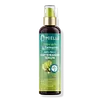What's inside
What's inside
 Key Ingredients
Key Ingredients

 Benefits
Benefits

 Concerns
Concerns

 Ingredients Side-by-side
Ingredients Side-by-side

Water
Skin ConditioningVp/Va Copolymer
Tocopherol
AntioxidantAloe Barbadensis Leaf Juice
Skin ConditioningHelianthus Annuus Seed Oil
EmollientGlycine Soja Seed Extract
Skin ConditioningBetula Alba Bud Extract
Skin ConditioningMalva Sylvestris Extract
AstringentAchillea Millefolium Extract
CleansingChamomilla Recutita Flower Extract
MaskingEquisetum Arvense Extract
AstringentLavandula Angustifolia Extract
Skin ConditioningRosmarinus Officinalis Leaf Extract
AntimicrobialSalvia Sclarea Extract
AntiseborrhoeicThymus Vulgaris Extract
PerfumingTussilago Farfara Flower Extract
AstringentUrtica Dioica Extract
AstringentCitric Acid
BufferingPhenoxyethanol
PreservativeParfum
MaskingWater, Vp/Va Copolymer, Tocopherol, Aloe Barbadensis Leaf Juice, Helianthus Annuus Seed Oil, Glycine Soja Seed Extract, Betula Alba Bud Extract, Malva Sylvestris Extract, Achillea Millefolium Extract, Chamomilla Recutita Flower Extract, Equisetum Arvense Extract, Lavandula Angustifolia Extract, Rosmarinus Officinalis Leaf Extract, Salvia Sclarea Extract, Thymus Vulgaris Extract, Tussilago Farfara Flower Extract, Urtica Dioica Extract, Citric Acid, Phenoxyethanol, Parfum
Alternatives
Ingredients Explained
These ingredients are found in both products.
Ingredients higher up in an ingredient list are typically present in a larger amount.
Parfum is a catch-all term for an ingredient or more that is used to give a scent to products.
Also called "fragrance", this ingredient can be a blend of hundreds of chemicals or plant oils. This means every product with "fragrance" or "parfum" in the ingredients list is a different mixture.
For instance, Habanolide is a proprietary trade name for a specific aroma chemical. When used as a fragrance ingredient in cosmetics, most aroma chemicals fall under the broad labeling category of “FRAGRANCE” or “PARFUM” according to EU and US regulations.
The term 'parfum' or 'fragrance' is not regulated in many countries. In many cases, it is up to the brand to define this term.
For instance, many brands choose to label themselves as "fragrance-free" because they are not using synthetic fragrances. However, their products may still contain ingredients such as essential oils that are considered a fragrance by INCI standards.
One example is Calendula flower extract. Calendula is an essential oil that still imparts a scent or 'fragrance'.
Depending on the blend, the ingredients in the mixture can cause allergies and sensitivities on the skin. Some ingredients that are known EU allergens include linalool and citronellol.
Parfum can also be used to mask or cover an unpleasant scent.
The bottom line is: not all fragrances/parfum/ingredients are created equally. If you are worried about fragrances, we recommend taking a closer look at an ingredient. And of course, we always recommend speaking with a professional.
Learn more about Parfum